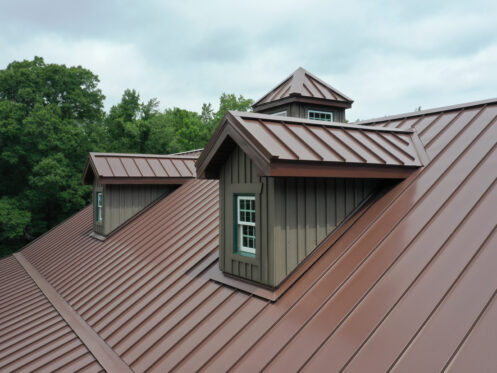The roof over your head does more than protect you from the rain; it plays a big role in how much energy your home uses. In a place like South Carolina, where the heat and humidity stick around for much of the year, choosing the right roof design can make a real difference.
Roof Shape Is Critical
The shape of your roof affects how heat moves across your house, how fast rain runs off, and how your attic handles air. In warm climates, simple shapes tend to do better. A low-slope roof, for example, gives the sunless surface area to hit straight on. That keeps heat from soaking in too fast. On the other hand, hip roofs, with four slopes instead of two, create better airflow under the surface. That movement of air helps reduce trapped heat, which means less stress on your cooling system.
Think about how your attic sits under the roof, too. The way heat builds in that space can change how comfortable your home feels. Roofs with ventilation space built into the design, like gable or vented hip roofs, give hot air a way to escape. If the hot air has nowhere to go, it just builds up and pushes down into your living space. A good roof shape helps keep that from happening, especially in hot, sunny weather.
Light Colors Make a Big Difference
When it comes to energy savings, the roof color matters more than you might expect. Lighter shades reflect more sunlight while darker ones pull heat in. In a climate where the sun shows up nearly every day, that heat adds up quickly. A dark roof can make your attic feel like an oven by midafternoon, which means your air conditioner has to work even harder just to keep things comfortable.
Choosing a light gray, tan, or even white roof can help bounce some of that sunlight away. That means less heat gets trapped, and your home stays cooler. This simple switch can help cut down how much you rely on your air conditioner, especially when the summer heat drags on. Some roofing materials also come with built-in reflective coatings.
Metal Roofing Performs Well in the Heat
Metal roofs might sound like something you’d see on a barn or workshop, but they’ve become a smart choice for homes, too. They handle heat really well and don’t hold onto it like asphalt or tile might. Once the sun goes down, the metal cools quickly. That means less warmth radiating into your attic in the evening when your house should be winding down.
Another plus of metal is its smooth surface. Water and leaves usually slide off metal roofs without trouble, and their reflective surface helps keep heat from soaking in. Some types even have coatings that reflect even more sunlight. If you’re thinking ahead and want something built to last, this is a solid option to explore. Metal roofs tend to outlast many others and can help reduce cooling costs when the weather gets hot.
They also work well with added features like solar panels. Because metal roofs are lightweight and sturdy, they give you a good base if you ever want to add solar power to your home in the future. The up-front cost can be higher than shingles, but the energy savings and long lifespan help balance that out.
Attic Ventilation Shouldn’t Be Overlooked
It’s easy to think your roof only matters on the outside, but what’s happening under the surface plays a big part, too. Attic ventilation helps manage heat and moisture. Without it, the air under your roof becomes stale and hot, which raises temperatures inside your home. When air moves through the attic, it helps carry that heat out before it can settle into your living spaces.
Good ventilation also helps with humidity. Warm, damp air that gets trapped in the attic can lead to mold or warped wood. In places where rain mixes with heat, that moisture builds fast. A roof with ridge vents, soffit vents, or powered fans helps keep things balanced. When the air moves freely, your insulation works better, and your HVAC system doesn’t need to run as long.
Even if you already have vents, it’s worth checking to see if they’re working properly. Sometimes, older systems don’t move air as well as they should, and simple upgrades can help improve airflow without a major rebuild.
Shingle Material Makes a Difference
Not all shingles behave the same under the sun. Traditional asphalt shingles tend to soak up heat and hold it, which can make your attic hotter than it needs to be. They’re common because they’re affordable and easy to install, but they might not be the best fit if you’re trying to lower your energy use.
There are other materials out there that do a better job with heat. Clay or concrete tiles have a natural resistance to high temperatures. Their shape allows air to flow underneath, which helps keep surfaces cooler. Slate is another strong option although it tends to be heavier and may not work with every roof structure.
Some asphalt shingles now come with reflective granules that reduce how much heat gets absorbed. If you like the look of shingles but want better performance, these are worth checking out. They’re made to match the appearance of standard shingles but with an added advantage of energy savings.
Roof Overhangs Help Block Direct Sun
A roof that extends beyond the walls of your home does more than give you shade on the porch. That overhang plays a big role in keeping the sun out of your windows during the hottest parts of the day. When sunlight hits your windows, it heats the inside of your home quickly. Curtains and blinds can help, but it’s better to block that heat before it even gets inside.
Longer roof overhangs can shade upper-floor windows and protect exterior walls from too much direct sun. That helps lower the temperature inside without using extra energy. It also keeps paint and siding from fading as fast, which means less maintenance for you down the road.
You don’t need an extreme overhang for it to work. Even a modest extension, planned at the right angle, can provide enough shade to make a noticeable difference in comfort. This is especially helpful on south- and west-facing parts of your home where the sun hits hardest in the afternoon.
Cool Roofing Tech Offers New Options
Cool roofing isn’t just a trendy label. It’s a type of roofing material made to reflect more sunlight and hold less heat. You can find these materials in a variety of styles, like shingles, metal sheets, or tiles. They’re made to keep the roof surface cooler, which helps lower the temperature inside your house as well.
Some cool roofs include added insulation that improves thermal performance. Others use special paint or coatings that reflect infrared light. The goal is the same in every case: less heat entering the home, more comfort inside, and reduced demand on your air conditioner.
You don’t have to go high-tech to get results. Even small upgrades, like a reflective coating applied to an existing roof, can help reduce heat buildup.
Update Your Roof Today
A roof that’s built with energy efficiency in mind allows your HVAC system to work less, helps your home stay cooler in the summertime, and ensures your wallet stays a little heavier. Whether you’re building a new roof or updating an old one, it’s worth looking at designs made for your local climate. We can handle all your roofing services. If you’re ready to explore your options for roof replacement, contact us at Fraser Roofing, LLC for honest advice and expert assistance in Greenville, Spartanburg, or the surrounding areas.

